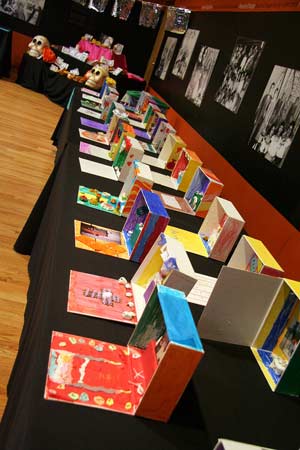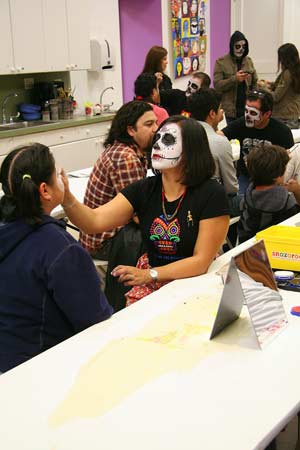Where did you celebrate the Dia de Muertos night? Gozamos spent the night of November 2nd at no other than The National Museum of Mexican Art in Pilsen, the epicenter of Mexican Arts and Culture in Chicago. And we were not disappointed. When the National Museum of Mexican Art calls it a community night they mean it. It was indeed an event for and by the community. People from all over Pilsen and surrounding neighborhoods came with their families to celebrate together Dia de Muertos in a special night organized by the Education department at the museum. It was a special occasion to keep the museum’s doors open until late and just celebrate.
Approximately six hundred guests attended throughout the night to participate in the activities. رهان كرة القدم The Dia de Muertos face painting was the most popular – especially among the little ones. The museum felt more like a neighborhood cultural center than anything, and people entered and left the museum as if they were in their families’ or friends’ homes. If the museum intended to represent a “home” for everyone in the community, it hit the nail on the head.

What we found at the event was incredible raw talent coming from a new generation of artists. Rows of Day of the Dead art displays made by Chicago Elementary school students framed the largest of the event’s halls. Small in size but grand in meaning were all of the altars created by young artists from Perez and Cooper Elementary Schools in Chicago. The altars included personal photos and objects, favorite dishes, skulls…colorful art with a very personal story behind. It was touching to witness the care and love these children put in the altars’ craftsmanship and the messages they left for those they cared about. Who knows, perhaps in a few years we will be viewing some of their work exhibited at this same museum?
Chatting with Erin Ding, one of the attendees, illustrated how universal Dia de Muertos, and this community night, really is. Erin is Chinese-American, wrote her school thesis about the Chinese-Mexican population in Mexico, and has been attached to the Mexican culture ever since. She brought her toddler Chandler to experience his first Dia de Muertos. She said “I really want my son to experience this. Dia de Muertos, and death in general, is nothing to be afraid of; It is something celebratory. I want my son to learn as many cultures as possible and this is a great event for that”.
The museum focuses on art and culture education and it was apparent during the event. A set-up serving hundreds of children and parents helped them to create skull masks, cempasúchil flowers and Catrina and Catrin puppets. This was one of the most visited spots. After such an exhausting creative session, children had the opportunity to taste some of the pan de muerto and a glass of agua fresca made out of tamarindo or horchata. And after they recharged their batteries, they could get their carita painted.
During the event, we sat down with Nancy Villafranca, Director of the Department of Education at the NMMA, and discussed the origins of the event and its significance to the Chicago community:
M: How did this Community Night event come up?
N: The Education Department at the museum has been planning educational programs in collaboration with the Day of the Dead exhibit for many years. In our department, we host art classes for children and adults, even events specifically for teachers who want to take Dia de Muertos into their classrooms. From September to December every year, approximately six hundred groups of students come to see the museum and we give them a tour. Our priority is to share how rich the Mexican culture is. We believe that art is like humanity’s soul, so we really focus on making children learn how to express themselves through art and how to live their culture. كازينو اون لاين عربي
The first time we hosted a community night was when actress Maria Felix died. It was such a huge loss for the Mexican artistic community that we felt we needed to honor her. We made an ofrenda for her and people really responded. From there, we began integrating more and more aspects to this event. Some people from the department went to Oaxaca, Mexico to check out how active the tradition really was. What we found was comparsas, bailes, altares, sand paintings, panteones full with people, color, flowers, light…the tradition was so alive and engrained in the culture that we understood we needed to continue all that here at the museum. We try to integrate all the components of our department in this one night.
M: What is your main goal with this event?
N: We want people to learn that Dia de Muertos is for everyone. People who attend, leave knowing that it is not a frightening tradition; it is a beautiful celebration and it is a very positive way to see death, the cycle of life…We want people to be very proud of their tradition. لعبة بينجو اون لاين
M: What are we going to find here tonight?
N: You are going to find Adelitas (casual attire) and Catrinas (fancy attire) walking around the event, children and parents making crafts that they can add to a community altar that we have here and artworks from students that have been a part of our programs. In terms of food you will find aguas frescas made out of natural fruits: jamaica leaves, horchata, limon, tamarindo, melon…and of course pan de muerto.

M: How do people really celebrate Dia de Muertos in Mexico?
N: From October 31st people stay overnight at the cemeteries to receive the souls. The 1st of Nov they normally celebrate the angelitos, the souls of the children who have passed away, and on the 2nd they celebrate all of the deceased. People normally make a general altar for the people they are honoring and then a little one for all those people that everyone seems to have “forgotten”, so everyone remembers them. There is an indigenous saying that goes “there are three deaths: the one when the person breaths for the last time, the one when the person is buried and the one when people forget about them.”
We want people to identify November 2nd with the Community Night at the museum and celebrate it both at their home and the museum. Grieving for someone is always healthy to be shared with the community. This museum is part of the community and we want people to come and share their lives with us and live their culture here.
Our chat with Nancy Villafranca strengthened our understanding of the important role this museum has in Chicago. The National Museum of Mexican Art is a perfect example of how a cultural institution blends perfectly in a Chicago neighborhood and represents the voice of the community. Educating people, especially children, to celebrate their culture without stereotypes, is challenging. When it comes to Dia de Muertos, this museum does a great job of spreading the authenticity of the tradition and keeping it alive. Next year, make sure you attend this event and bring your little ones with you. I will guarantee you they will find that Dia de Muertos is everything but scary; they will have no nightmares, but sweet dreams of catrinas, skulls and cravings for more delicious pan de muerto.
The National Museum of Mexican Art is located at 1852 W 19th st, Chicago. For more information about this event or the NMMA visit: www.nationalmuseumofmexicanart.org
See slideshow of Day of the Dead Community Night at NMMA on Flickr »